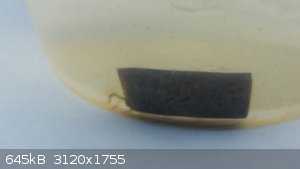
veerenyadav - 17-6-2015 at 19:53
Is there any chemical which can reduce Fe2O3 into Fe3O4 in normal water solution ?
kecskesajt - 18-6-2015 at 04:16
Well,I think not.But you could add HCl to it to form FeCl3.Half the solution and for one half add an excess iron metal.Let it sit for a day without
oxygen and then filter off the sol.Pour the 2 solution into one.After that,add enough NH3 solution untill no more precipitate forms.Filter off and you
have magnetite.
AJKOER - 18-6-2015 at 11:05
OK, magnetite has been described by the chemical formula, Fe2O3.FeO (see, for example, discussion in Wikipedia at
https://en.m.wikipedia.org/wiki/Iron(II,III)_oxide and at http://iron.atomistry.com/magnetites.html ). As such, I would speculate that one may be able to prepare it by suitably combining (that is, in a
manner consistent with the general preparation of mixed salts, concentrated solutions and much stirring) a fresh precipitate of FeO.H2O (or, more
commonly written as Fe(OH)2 ) with Fe2O3.3H2O (=2Fe(OH)3). The latter two hydroxides can be formed by the respective action of a base on a
corresponding ferrous or ferric salt.
In fact, to quote a source (link: http://www.sciencedirect.com/science/article/pii/S0927775702... ):
"Magnetite nanoparticles were prepared by coprecipitation of Fe2+ and Fe3+ with NH4OH"
[Edit] and in another more detailed reference, "New route for preparation and characterization of magnetite nanoparticles", by M.A. Abdalla, et. al,
to quote from the abstract:
"We report here the synthesis of naked magnetic nanoparticles by using a facile method. Magnetic nanoparticles were prepared by mixing and stirring
two equivalents of iron(II) chloride tetrahydrate with three equivalents of iron(III) chloride hexahydrate at room temperature. The mixture was
treated by adding 100 ml of 28% ammonium hydroxide. Immediately, the color of the solution turned from orange to black. The magnetite nanoparticles
that precipitated were washed three times with 5% NH4OH solution using the magnetic decantation method."
Link: http://www.sciencedirect.com/science/article/pii/S1878535210...
[Edit] Note, there is no reduction in the above suggested reactions. In my opinion, this path is, in essence, a preparation of a mixed salt (of which
I have some experience).
[Edited on 18-6-2015 by AJKOER]
Chiral Case - 18-6-2015 at 11:19
If you want to use an organic reducing agent in Kecskesajt's method, I suspect oxalic acid might work. Kecskesajt's method uses iron to reduce
Fe3+ to Fe2+. Oxalic acid has a standard electrode potential similar to metallic iron, so that should also work.
[Edited on 18-6-2015 by Chiral Case]
Pumukli - 18-6-2015 at 11:41
Once I made Fe(III)-oxalate by mixing an Fe(III) salt and oxalic acid (or its salt). It did not reduce Fe(III) to Fe(II) for sure but gave a nice
yellow precipitate.
DraconicAcid - 18-6-2015 at 11:50
Oxalate will form an insoluble precipitate with iron rather than reducing it. In excess oxalate, you get a lovely green complex.
Chiral Case - 18-6-2015 at 14:58
I totally forgot about the bidentate nature of oxalate. However, while browsing wikipedia on iron(III) oxalate and related oxalates, I found out that
it's still redox active. For example, potassium ferrioxalate can undergo photoreduction. I agree that using oxalic acid will not be the easiest route
to magnetite, but the other methods don't involve an organic reducing agent. How important is the request for an organic reducing agent?
Fe2O3 Reduction
veerenyadav - 18-6-2015 at 23:22
Thanks to all
but I do not want iron compound like Iron oxalate, iron chloride, etc. It should be like reduction using Carbon/co/ etc which just take away oxygen.
kecskesajt - 19-6-2015 at 01:19
If you want to do with carbon,carbon monoxide or hydrogen you need heat.A lot.
AJKOER - 21-6-2015 at 13:31
Interestingly, one can fairly quickly visibly produce Fe3O4, a black solid, by first boiling iron in distilled water (previously recently boiled to
remove oxygen) in a microwave for 30 seconds containing some sea salt with a plastic wrap to seal off oxygen and after 5 minutes, reheating in the
microwave for 30 seconds (see photo, some 7 hours into the reaction). To quote Wikipedia, https://en.m.wikipedia.org/wiki/Schikorr_reaction :
"Anaerobic corrosion of metallic iron to give iron(II) hydroxide and hydrogen:
3 (Fe + 2 H2O → Fe(OH)2 + H2)
followed by the Schikorr reaction:
3 Fe(OH)2 → Fe3O4 + 2 H2O + H2
give the following global reaction:
3 Fe + 6 H2O → Fe3O4 + 2 H2O + 4 H2
3 Fe + 4 H2O → Fe3O4 + 4 H2 "
Per another source, "Corrosion of carbon steel under sequential aerobic–anaerobic environmental conditions", link: https://www.google.com/url?sa=t&source=web&rct=j&... , the half reactions are given as:
Reduction of water: 2 H2O + 2 e- → H2 + 2 OH-
Oxidation of iron: Fe + 2 OH- → Fe(OH)2 + 2 e-
followed by the Schikorr reaction as detailed above. Note, sea salt is added to provide an excellent electrolyte which accelerates the electrochemical
half reactions. To quote a source https://www.google.com/url?sa=t&source=web&rct=j&... :
"A laboratory simulation study of the impact of pH and chloride content on the corrosion of cast iron and mild steel was conducted. There was a linear
relationship between the corrosion rate of cast iron and the log of chloride ion concentration in the pH range 7.8< pH >5.5 with only a small pH
effect noted for the given range of conditions. Studies on a 19th century mild steel sample indicated that the corrosion rate was linearly dependent
on the square root of the chloride ion concentration and the corrosion rate fell in a linear fashion as the pH was increased to strongly alkaline
solutions of sodium hydroxide. "
I further suspect that the combination of using a microwave (providing a temporary elevation of solution temperature to boiling, source of
radicals,..) and the minerals/impurities in sea salt itself (ranging from bacteria to sulfates, iodides..), may contribute to the reaction speed as
well as the normal expectation at RT is otherwise slow.

[Edited on 22-6-2015 by AJKOER]
